In the long term, anything that is not sustainable has only one option: vanish.
Content on this page:
- Achieving net-zero carbon dioxide emissions by 2050
- Digital (energy) madness
- How 2000-watt-neighborhoods reduce power consumption
- Political discourse and reality
- Preferred values of a democratic 2000-watt-society
- Challenges for democratic societies
- Photos of 2000 watt neighborhoods
- Interview with Nate Hagens "The Realities of Living a Low(er) Energy Lifestyle" (YouTube)
Achieving net-zero carbon dioxide emissions by 2050
In our industrialized societies, fossil and electric energy is everywhere. The not yet translated German and French books shows how our modern societies can succeed the transition to a post-oil society without too much turmoil. The challenges are numerous and some are gargantuan, above all if global warming is to be limited to 2°C. But the “2000-watt-neighborhoods” in Switzerland show a promising path towards a post-oil society. A permanent power-consumption of 2000 watts (48 kWh per day) by each human is considered to be sustainable and can be produced by renewable energies. The current power consumption between 5000 and 10 000 watts in industrialized nations is not sustainable. If we accept global warming exceeding 3°C and all the catastrophes and costs that will come with it, such a high level of power consumption may last for another 30 years, till most reserves of crude oil and natural gas will be exhausted and the gap of lower fossil fuel production is filled by added renewable and nuclear energies.
The following graphic shows the historical evolution of the use of primary fossil energy, converted to Tera-Watt-Hours (TWh) :
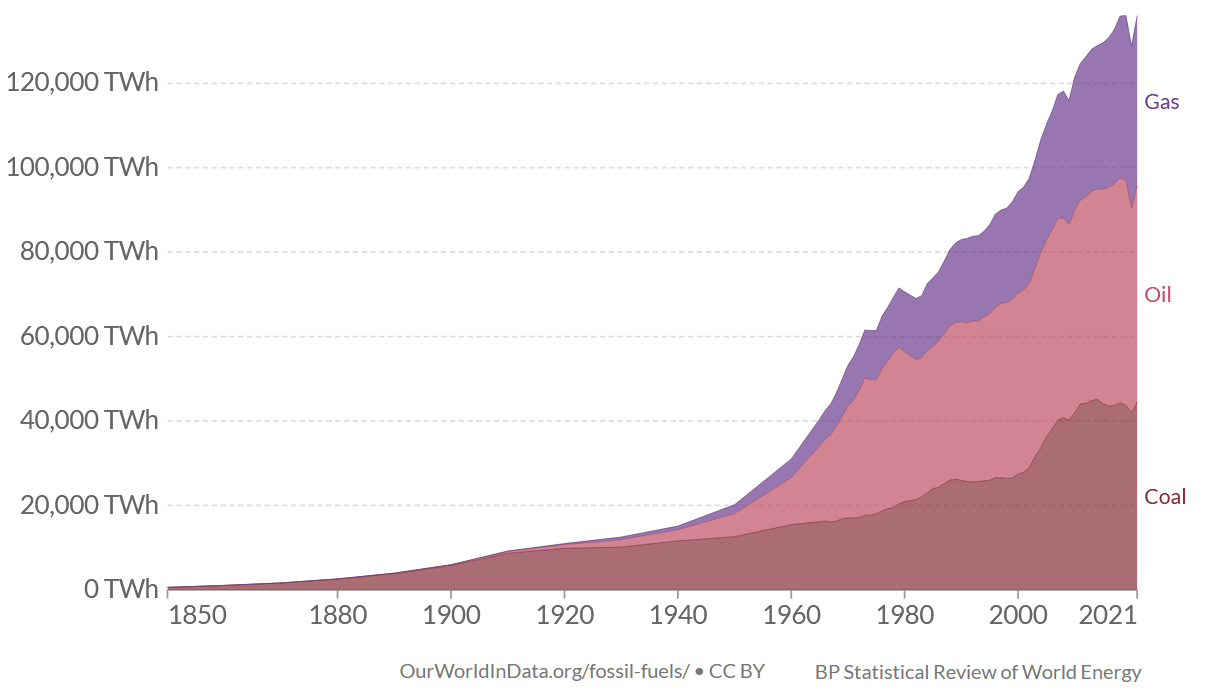 The graph shows the evolution of fossil energy consumption. Greenhouse gas emissions follow the same curve. Growth inversions on this graph show the major economic crises (oil-crisis, financial crisis, Covid-19 pandemy). The global climate summits have not reduced the use of fossil fuels. Their use was almost doubled since the second climat summit of 1990 to reach a new record of 137'000 TWh in 2023.
The graph shows the evolution of fossil energy consumption. Greenhouse gas emissions follow the same curve. Growth inversions on this graph show the major economic crises (oil-crisis, financial crisis, Covid-19 pandemy). The global climate summits have not reduced the use of fossil fuels. Their use was almost doubled since the second climat summit of 1990 to reach a new record of 137'000 TWh in 2023.
These 134 000 TWh of primary fossil energy correspond to about 100 000 TWh of useful carbon-free electric energy if all industrial processes and human activities were changed to carbon-free energy sources. The book shows that humanity doesn't have the means to replace all fossil fuels with renewable or zero-carbon energies till 2050. The cost (CAPEX) is simply too high to be socially acceptable. According to our rather optimistic estimates, worldwide investments of over 260 000 billion (US billion=109) dollars would be needed to replace all fossil fuels with renewable energies and energy storage. For the European Union, investments of 60 000 billions would be needed. The cost calculations already take into account a steady cost-reduction for renewable energies and energy storage. By way of comparison, 260 000 billions corresponded to 350 years of investments of the entire oil and gas industry or to three times the sum of the bond-debts of all countries and companies of the world in 2020. The detailed calculations and estimates of investments to replace all fossil fuels can be downloaded from the “Download” menu.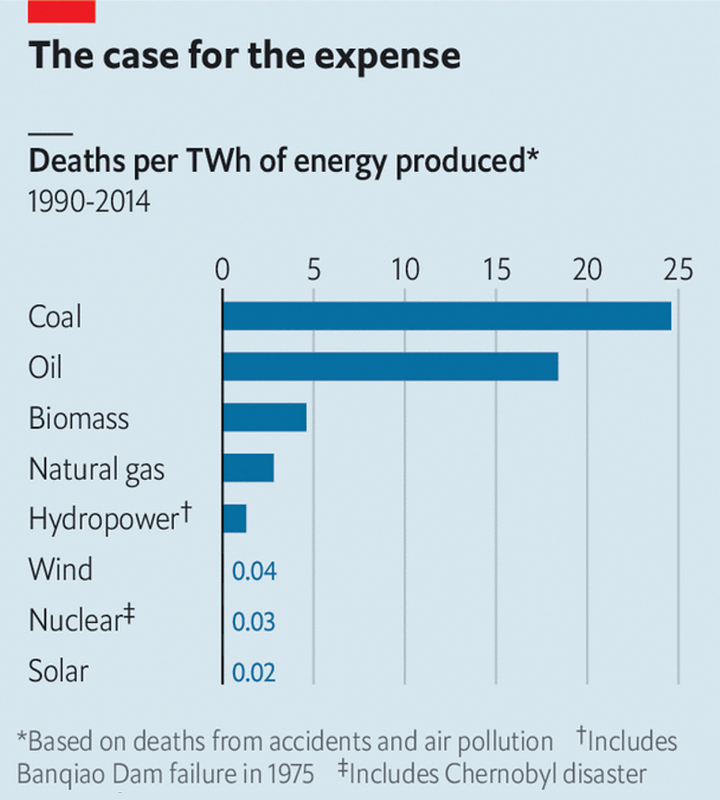
Due to the high costs of renewable energies, no operational nuclear power plant should be shut down for ideological reasons before climate neutrality has been achieved! In the case of radioactive nuclear waste, we are not sure whether final storage in deep layers of the earth will cause any unforeseen problems during the next 1000 years. However, for every megaton of CO2 emitted by a gas or coal-fired power plant, we are certain that it will cause global warming over the next 1000 years. Like all oxides, carbon dioxide is an extremely stable molecule. It takes about 10 000 years for 90 % of a megaton of CO2 to disappear from the atmosphere.
If investments in the energy sector are tripled, the European Union (EU) will be able to replace about a third of its fossil fuels with renewable energies over the next 30 years. Furthermore, if no nuclear power plant is closed, we may create the 2000-watt society and carbon neutrality by 2050. The book shows that the 2000-watt-society is a reasonable goal if we multiply the investments in the energy sector by three[1] and at the same time divide the energy consumption by two or three. The book expects constant technological progress but no "technological miracles" since R&D spending in power and energy storage is much too low, only about 0.005% of GDP in the most industrialized countries [2].
The 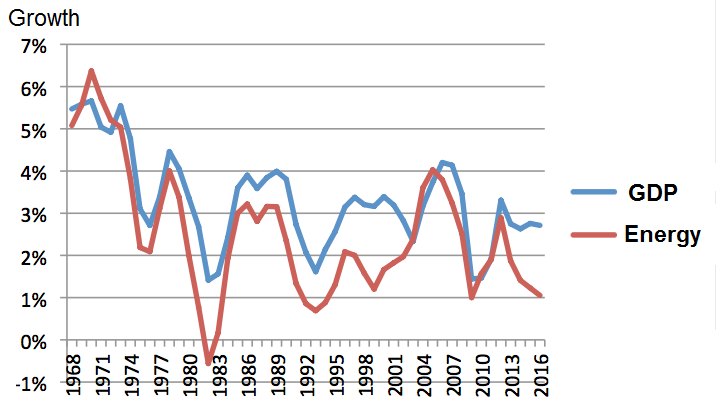 Correlation between growth and energy consumption. Source : OurfiniteWorld.com Meadows from the MIT showed the same correlation in his book "Limits to growth", published in 1972.book shows that humanity may have the means to replace a third of all fossil fuels, the rest must be done by reducing energy needs, improving energy efficiency, and reducing the purchase of energy-hungry objects and services. The book shows also that there exists a strong correlation between energy consumption and GDP since our income depends largely on the number of machines that are working for us, very visible in highly automated factories. Therefore, reducing energy consumption will automatically reduce GDP and therefore reduce the average individual income. This is one of the reasons why moving to the post-oil society may increase the already strong tensions within our societies. If our democratic societies do not organize themselves differently, for example like the 2000-watt neighborhoods, these conflicts may tear our democracies apart and put an end to our prosperity. The financial challenges are such that during the transition to the post-oil society, we will still need nuclear power stations and we have to keep existing nuclear power plants working as long as their safety can be guaranteed. Closing nuclear power plants for ideological reasons is proof of ignorance of the financial challenges for achieving net-zero carbon emissions [3] while maintaining a decent way of life.
Correlation between growth and energy consumption. Source : OurfiniteWorld.com Meadows from the MIT showed the same correlation in his book "Limits to growth", published in 1972.book shows that humanity may have the means to replace a third of all fossil fuels, the rest must be done by reducing energy needs, improving energy efficiency, and reducing the purchase of energy-hungry objects and services. The book shows also that there exists a strong correlation between energy consumption and GDP since our income depends largely on the number of machines that are working for us, very visible in highly automated factories. Therefore, reducing energy consumption will automatically reduce GDP and therefore reduce the average individual income. This is one of the reasons why moving to the post-oil society may increase the already strong tensions within our societies. If our democratic societies do not organize themselves differently, for example like the 2000-watt neighborhoods, these conflicts may tear our democracies apart and put an end to our prosperity. The financial challenges are such that during the transition to the post-oil society, we will still need nuclear power stations and we have to keep existing nuclear power plants working as long as their safety can be guaranteed. Closing nuclear power plants for ideological reasons is proof of ignorance of the financial challenges for achieving net-zero carbon emissions [3] while maintaining a decent way of life.
Despite their sharp decline in energy consumption, the most advanced 2000-watt neighborhoods have a good standard of living, even after freely lowering their individual purchasing power.
Increasing energy efficiency through technological progress contributes to reducing energy consumption. Unfortunately, most technological advancements that improve energy efficiency are lost again due to lifestyle changes. According to a report of the International Energy Agency (IEA), humanity would need to improve energy efficiency by 5% per year over the next 30 years in order to achieve net-zero emissions. However, over the past 20 years, average energy efficiency improved by 1.5% only, and we only did the easy improvements so far. The book analyzes this problem and proposes solutions. Technological solutions alone will not get us to net-zero emissions!
CAPEX investment needed to replace 90% of fossil fuels by renewable and nuclear energy. Also included are hydrogene production for inter-seasonal storage and for steel production with direct-reduction process. Also included are investments in smart-grid infrastructure to tripple transport of electricity. Details available in Download menu.
Worldwide investments to produce and store energy : $ 240 000 billion
Europe's investments to produce and store energy : $ 55 000 billion
Total debt of all countries and companies (bond market): $ 100 000 billion dollars
The estimates above are based on the optimistic scenario of the NREL (National Renewable Energy Laboratory). The optimistic scenario assumes that there will be no shortage of raw materials and metals for the next 30 years and that the cost of energy to manufacture renewable energy equipment and its storage does not increase. Half the cost of solar panels and batteries is determined by the price of raw materials and the IEA predicts a shortage of raw materials between 2025 and 2030. Our estimates are therefore really optimistic. With the pessimistic scenario, the above numbers would have to be doubled. So even if the optimistic scenario shows amounts of investment beyond our socially acceptable means, a paradigm shift is needed if we want to avoid global warming exceeding 3°C !
Digital (energy) madness
The book also shows that 5G telephony, the interconnection of billions of new objects and the multitude of new Internet functions brought about by 5G and artificial intelligence (AI), will rapidly increase electricity consumption. According to forecasts by the International Energy Agency (IEA) and a study by Anders Andrae, an engineer at Huawei, this increase will go much faster than the electricity produced by new renewable energy. The new renewable energy installations will therefore not replace fossil energy, they will not even be able to supply electricity for the new 5G and new Internet functions [4]. Already in 2021, all data-centers in the city of Frankfurt consumed 1.6 times more energy than the city's 400,000 households (FAZ, Serverfarmen in der Stadt, 10/17/2021). Further data-centers are under construction even in that city.
Suppose that the number of searches made with systems like Chat-GPT4 one day equals those made by search engines like Google, Baidu or Qwant. In this case, the data centers of Chat-GPT4 and its competitors would consume the energy of 20 nuclear power plants. Details are available in the Download menu in an Excel file. Chat-GPT type of AI will only marginally increase work productivity, since the productivity gains of writers and journalists will be offset by the increasing number of fact-checkers needed to keep democracy alive. Many professions like lawyers use their own up-to-date AI based expert systems and don't really need Chat-GPT's outdated content, nor do they want the bias-producing internal preprompts that Chat-GPT needs in order to avoid inspiring criminal activities.
The energy balance becomes even more negative with Virtual Reality projects also called "metavers". The metaverse is a virtual representation of physical reality, for example streets, landscapes, shops, clubs and museums. The connection to the "metaverse" will usually be through a 3D virtual reality headset that records and sends people's movements, images and words to a data center. The "metaverse" will thus allow friends, each in their home with a virtual reality headset on their head, to take virtual walks together, as if they were walking together in a city on Google street-view, or as if they visited the Louvre Museum virtually together. In all these places, they will be able to virtually meet people who also walk around the Louvre virtually. As in real life, by paying with real euros, friends will be able to buy virtual luxury gadgets to impress the virtual people they meet in the "metaverse". These "metaverse" projects will produce unimaginable amounts of data streams and increase electricity needs accordingly. Not to mention the loss of the last place of privacy in our own homes. Activities in the "metaverse" will not diminish tourism, they will increase it, just as television documentaries have. The beauty of exotic countries attracted ever more tourists.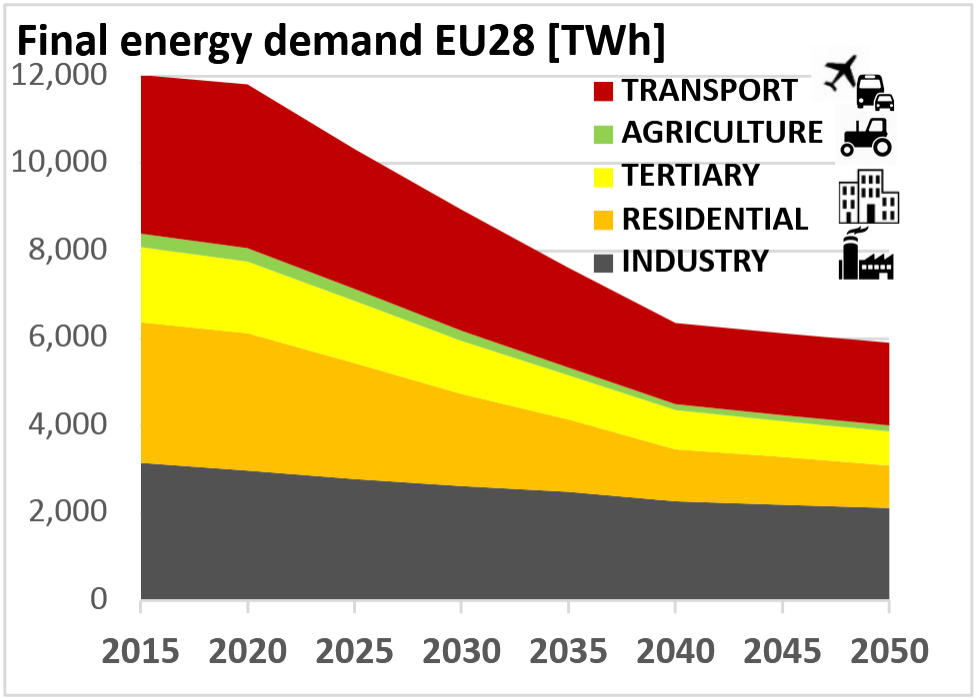 Source: Energy consumption pathway of the European Union. The total final energy of 6000 TWh is an equivalent of 1800 watts of permanent average energy use per capita. This graph does not include indirectly imported grey energy.
Source: Energy consumption pathway of the European Union. The total final energy of 6000 TWh is an equivalent of 1800 watts of permanent average energy use per capita. This graph does not include indirectly imported grey energy.
The miniaturization of electronic components will reach the limits of physics (end of Moore's law). From around 2026, the energy efficiency of data-centers will only improve marginally and their electricity consumption will then increase expontntially like the volume of data.
All these developments are in contradiction with the government's announcement to want to achieve net-zero carbon in 2050. Unfortunately, political and economic decision-makers ignore this "energy" parameter, although it is the basis of our industrial civilization. If we do not give the energy factor the highest priority in our political, economic and consumer decisions, we will end up with a global warming between 3°C to 4°C.
For all of these reasons, energy use has to be reduced by about the amount that the Swiss, French and German official energy paths show.
If the rich countries decide to maintain their average permanent energy consumption of about 6000 watts with investments into carbon-free power utilities exceeding 10% of the GDP, they will never be able to convince less rich countries to give up fossil fuels, because the cost of fossil fuels drops if rich countries consume less and less. To decarbonize their economies, developing countries need help from rich countries, as rich countries import all kind of products from countries with low labor costs. Indonesia, for example, has pledged to reduce CO2 emissions by 41% until 2030 if it receives aid from rich countries, but only by 29% without such aid.
How 2000-watt neighborhoods reduce power consumption
Regarding energy consumption, several 2000-watt-neighborhoods, managed by housing cooperatives, have considerably reduced their energy footprint. Without taking into account the energy needed for state infrastructure and services, some neighborhoods have almost reached the goal of 2000 watts of permanent energy consumption, which corresponds to about a third of the Swiss average in 2010. The book describes methods by which these neighborhoods achieve the goal of energy consumption of 2000 watts. This reduction in energy consumption is also the best response to global warming and social justice.
The buildings of the 2000-watt neighborhoods consume very little energy (10 to 12 kWh/m²/year), about 15 times less than the American average. The construction-costs are only 10% higher than Swiss average. Everything is optimized for low energy consumption, starting from the choice of building materials, architecture, ventilation, space optimization, etc. The book explains the most important points. A specialized book for architects illustrates and explains the details that make such extremely low energy consumption possible. It is available in the download menu.
 Cafeteria reserved for the inhabitants of the 2000-watt neighborhood Kalkbreite
Cafeteria reserved for the inhabitants of the 2000-watt neighborhood Kalkbreite
Considerably reducing energy consumption also implies reducing individual purchasing power. In order to maintain a good standard of living, the inhabitants of the 2000-watt neighborhoods share many objects and infrastructures such as repair workshops, a sewing workshop, laundry rooms, tiny apartments for guests, meeting and party rooms, a sauna, a library, but also cars and electric bikes belonging to the housing cooperative. The neighborhood also facilitates sharing of children's clothes, books and games when a family no longer needs them because a child has grown up. In principle, they share quality objects and infrastructures that are not often used by each inhabitant.
Let's suppose that 32 families in a 2000-watt neighborhood share 4 large professional washing machines, each one having a lifespan of 24 years. Manufacturing a professional washing machine needs about twice as much energy as manufacturing a family washing-machine. Let's compare the gray energy of these 4 professional machines with the 32 washing machines, one per family, of which each machine has an average lifespan of 7 years (average lifespan in France). Then, for the object washing machine, the grey energy of the inhabitants of a 2000-watt neighborhood is divided by 14 compared to the average household in France. With things that are used even less often, such as "do it yourself" tools and sewing machines, the grey energy saving is even more important. The book develops all the aspects of 2000-watt neighborhoods that allow energy savings without losing quality of life. Other aspects concern food, buildings, mobility, leisure time, social life of neighborhoods in the event of an epidemic and relations between big cities and rural communities.
However, if the savings made in the areas of housing and daily mobility are spent to consume more stuff, the energy balance does not really improve. For this reason, the book reflects on how to reduce the attraction of money and its power on the human mind, inspired by the practices of the most advanced 2000-watt neighborhoods. Our purchasing power, energy consumption and environmental footprint are closely linked. (Some further explanations in the menu "The book").
The table below shows the average permanent primary energy consumption per capita, without gray energies needed to create and maintain public infrastructure:
Swiss average per capita: 7000 watts(a) Residential only: 2000 watts
Advanced 2000 watt neighborhoods: 3500 watts(b) Residential only: 600 watts
(a) Swiss government data (b) included are 1300 watts for state infrastructure and services
In many countries, residents' cooperatives are very similar to the 2000-watt neighborhoods in Switzerland. If the buildings of these residents' cooperatives comply with the Swiss standard "Minergie-Plus-Eco", which is not easy, they can achieve the same energy performance as 2000-watt-neighborhoods in Switzerland. Like the 2000-watt neighborhoods in Switzerland, residents' cooperatives can reduce the use of gray energy by sharing infrastructure and objects. To continue advancing towards a lifestyle compatible with carbon neutrality, having a quantified and measurable goal (2000 watts) could be a source of inspiration for residents' cooperatives or for any other neighborhood trying to find a carbon-neutral lifestyle. Some advice on this subject can be found in the menu "Download, section Building and Standards".
Will the 2000 watt society create unbearable increase of unemployment ? Let us stick to the example of washing machines. Producing a small quantity of machines (8 times less in the example above) no longer justifies strongly automating factories, which saves energy. Creating very high quality products with a long lifespan requires well-skilled workers. Therefore, producing very good quality machines in smaller quantities saves energy and creates jobs. High-quality machines are more expensive, but the budget is shared since several households share a machine. If, moreover, equality between humans is oriented towards energy consumption, the salaries between the highest and least qualified people will automatically become smaller since material extravagances will cease to be symbols of social success and become a status for the destruction of the planet. However, the rich willing to do their fair share will still be able to buy luxury goods such as handmade mechanical watches, since making such a watch consumes much less energy than producing an electronic Apple-Watch.
 Simon & Garfunkel: I am a rock, I am an island 2000-watt neighborhoods are not a panacea for all human problems. The book describes some problems encountered in these neighborhoods and the implemented solutions. For sure, other problems will emerge in the future. In this context, it can be useful to know that there are notions of freedom, equality, fraternity and justice which make living together more or less conflictual. The book offers reflections on these notions, since living together and sharing objects in peaceful neighborhoods can not be taken for granted. Our individualistic societies will have to relearn how to live together and peacefully manage conflicts between neighbors. Only the abundance of cheap energy allowed us to live alone, caring for nobody, like "a rock that feels no pain and an island that never cries" (Simon and Garfunkel).
Simon & Garfunkel: I am a rock, I am an island 2000-watt neighborhoods are not a panacea for all human problems. The book describes some problems encountered in these neighborhoods and the implemented solutions. For sure, other problems will emerge in the future. In this context, it can be useful to know that there are notions of freedom, equality, fraternity and justice which make living together more or less conflictual. The book offers reflections on these notions, since living together and sharing objects in peaceful neighborhoods can not be taken for granted. Our individualistic societies will have to relearn how to live together and peacefully manage conflicts between neighbors. Only the abundance of cheap energy allowed us to live alone, caring for nobody, like "a rock that feels no pain and an island that never cries" (Simon and Garfunkel).
Political discourse and reality
In 1992 in Rio de Janeiro, most nations decided to reduce the environmental impact of human activities and greenhouse gas emissions [5] in order to maintain biodiversity to reduce climate change. In 1997 in Kyoto, Japan, this decision was reinforced. In 2009 in Copenhagen, most nations decided to limit global warming to 2°C, and in 2015 in Paris, they decided to aim for global warming below 2°C. But since humanity decided to drastically reduce greenhouse gas emissions in 1992, it has not reduced them, it has doubled them! It is therefore obvious that the materialist philosophy, which is dominant as much in China as in the West as elsewhere, does not help people to limit themselves before we all together hit the limits of the planet. Hitting these limits at full speed of GDP growth will produce a lot of upheaval, starvation and other miseries.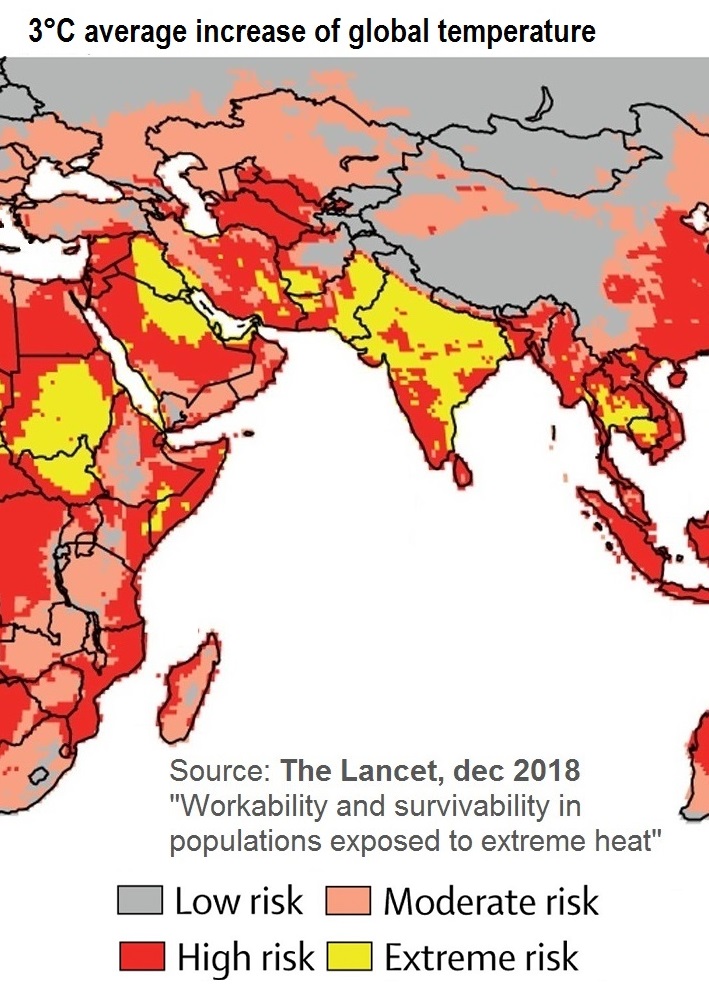 In the yellow zones live 1 billion humans.
In the yellow zones live 1 billion humans.
It is therefore essential to think about human values which encourage people to freely limit themselves. It is important to think about human values and priorities that encourage self-limitation and yet allow scientific progress. Self-limitation means voluntarily limiting one's purchasing power and exercise of power over nature and fellow human beings. The dominant values of the last half a century have to change. We need a philosophy that prefers human relations over an ever-increasing amount of material goods, prefers quality to quantity, values serenity more than emotions from speed, and sees in nature more than a means to get rich while assuming the right of its free exploitation.
Looking at the evolution of industrialized nations since 1992 makes it difficult to see how a voluntarily materialistic philosophy could produce a society that values relationships and serenity more than stuff, machines, data centers and transhumanist gimmicks. According to the most probable scenario of Bloomberg's New Energy Outlook (NEO 2020), the current system logically leads us towards a global warming of 3°C by 2100, compared to a warming of 1.2°C during the last 150 years. Under this scenario and given the inertia of the climate system, global warming is likely to stabilize close to 3.5°C, producing ever more extreme weather conditions. The cost of adapting to extremer weather will be much higher [6] than building the 2000-watt society.
Humans do not survive with temperatures above 35°C and humidity above 90% (or 39°C and 50%), which will be the case in large parts of India, Pakistan, the Middle East and South America. A medical study published in The Lancet shows that about a billion people will live in places that become uninhabitable for several months each year. With an average temperature increase of 3°C, temperatures above the sea will increase by 2.5°C and about 4.5°C on the mainland.
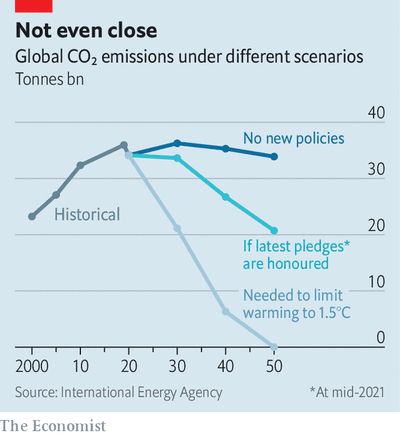 Equally alarming is the latest report from the Intergovernmental Panel on Climate Change (IPCC). Even if the States respect their commitments made at COP21 in Paris, which is currently not the case, the planet would warm by at least 3°C by 2100.
Equally alarming is the latest report from the Intergovernmental Panel on Climate Change (IPCC). Even if the States respect their commitments made at COP21 in Paris, which is currently not the case, the planet would warm by at least 3°C by 2100.
In 2020, during the Covid-19 epidemic, many states announced that they wanted to invest a total of $ 16 000 billion for economic recovery. In a special report, the IEA proposed that a quarter of this huge amount be used to invest in renewable energy utilities. In July 2021, the IEA finds that only 2% of the 16 000 billion is forecast for renewables and that CO2 emissions are likely to reach a new record in 2023.[7] According to the 2015 Paris agreements, CO2 emissions should decline by 20% until 2025, but instead, humanity will likely set a new CO2 emissions record. It is therefore essential to think about human values which encourage limiting oneself while leaving room for scientific progress.
If we take into account the CO2 balance of the imported and exported products and therefore the imported grey energy, almost all countries are moving in the wrong direction, both capitalist and communist economic systems. Since countries with different political and economic systems move in the same wrong direction, the problem is probably also of a philosophical nature, for a materialist philosophy with a tendancy to transhumanism is more or less dominant in most capitalist or communist countries.
Jacques Ellul writes on this subject in "Living and thinking about freedom" (p.235): "Humans are considered exclusively as consumer-producers. This is, for example, as much the case in the communist materialist doctrine as in American materialist practice. In both systems, humans are instruments of production. And the whole life of man is oriented towards this one goal. ... We do not care about man as a man but as a producer, and all interests about him are not very different from the interests we have in the best machines."
Preferred values of a democratic 2000-watt-society
Reducing energy consumption needs sharing infrastructures and high quality objects in a neighborhood. That in turn requires changes in the dominant values. The individualist consumer-culture is too focused on individual rights and purchasing power. It favors narcissism as narcissists need everything and share nothing. That's good for the GDP, but is not sustainable. A candidate for the presidency of the Republic will never be elected if he promises a steady decline in individual purchasing power over the next 50 years. The consumer culture has almost deified money and purchasing power. The book develops ways for reducing the influence of this pitiless deity. For all these reasons, the book offers a reflection on the motto of the French Republic: liberty, equality, fraternity. Unfortunately, this motto is often used like a publicity slogan. But a good understanding of this motto helps to produce the values that will be essential for living well in a 2000-watt society, without first going through civil chaos and state oppression.
Looking at the evolution of industrialized nations since 1992, it is difficult to see how a deliberately materialistic philosophy could produce a society that values nature, relationships and serenity more than objects, machines, datacenters and transhumanist gadgets. Even after trying hard, I can't see how such a philosophy can encourage a society to freely renounce purchasing power and therefore power over nature, other humans and animals.
Since practical initiatives come from their inhabitants and their work groups, the 2000-watt neighborhoods need freedom. Equal energy consumption dramatically reduces inequalities in lifestyle, an original response to growing inequalities. The current inequalities in our societies produce a lot of mimetic desires (cf. René Girard), which increase the GDP of a wasteful consumer culture, but these desires make reducing energy consumption close to impossible. Fraternity facilitates the sharing of infrastructures and favors collaboration in various work-groups, even between people of different origins, clearly visible in the 2000-watt neighborhoods.
The 2000-watt neighborhoods oppose the materialist philosophy which produces an increasingly individualistic consumer-society, and for which the "good life" consists mainly of purchasing ostentatious goods. Materialism has been spreading for more than 50 years, produced the dominant values in our societies and finds its latest goals in transhumanism. This materialist philosophy has also a very special understanding of the motto of the French Republic. This philosophy ...
- reduces humans to "biological machines", freedom to a wide choice in front of supermarket shelves and "free will" to a psychological illusion (B.F. Skinner, G. Roth, J.P. Changeux);
- considers the equality of humans as an illusion derived from Jewish and Christian myths (Y. Harari) and prefers an egalitarianism whose remote ideal would be the equality of human clones (A. Huxley);
- considers fraternity as a silly anachronism, since human relations are above all determined by the "will to power" (Nietzsche).
The most effective deception of our socio-economic system is to make us believe that personal freedom invites us to do whatever we desire, without thinking about the consequences and without moral considerations. This allows advertisers to manipulate our desires, allows TV stations "to sell available brain-time" (CEO of the French channel TF1 about the efficiency of advertisements) and allows economists to say "household morale is good" because households spend lavishly. This "freedom" is a deception because it is easily manipulated. Such "freedom of desires" requires unlimited growth of consumer-spending and is not sustainable because it will generate ever more serious ecological and social problems. Because of social instability, that type of "freedom" can eventually be used as a pretext to reduce the freedom of all. An IEA report from May 2021, of which Chapter 5 provides a short overview, shows the importance of behavioral changes to achieve net-zero carbon emissions. Chapter 7 of the book offers reflections on a type of freedom that liberates from materialistic consumer-propaganda.
The book proposes a philosophy that allows us to create a democratic post-oil society, in the spirit of the 2000-watt neighborhoods, and guided by a phrase from the philosopher Francis Schaeffer: "Every society evolves slowly, but surely, towards the logical conclusions of its dominant philosophy ".
The materialist philosophy reduces almost everything to its economic utility, proposes to solve social problems mainly through growth of GDP and divides the society into multiple communitarian identities according to the principle "Divide et impera", divide and conquer (Machiavel). For the last 20 years, many American universities have been teaching theories that divide society into a multitude of more or less irreconcilable communities. It should therefore come as no surprise that today, large urban centers in the United States are more segregated and fractured than in 1990 [8]. Mutual ignorance and hatred between communities is steadily increasing, or as political scientists call it, "affective polarisation" increases [9]. Several studies have shown that about 70% of American college students have more narcissistic traits and less empathy than 30 years ago [10]. The book shows the consequences of this philosophy and makes proposals for another philosophy that encourages self-limitation, fraternity and support for the weak of all communities.
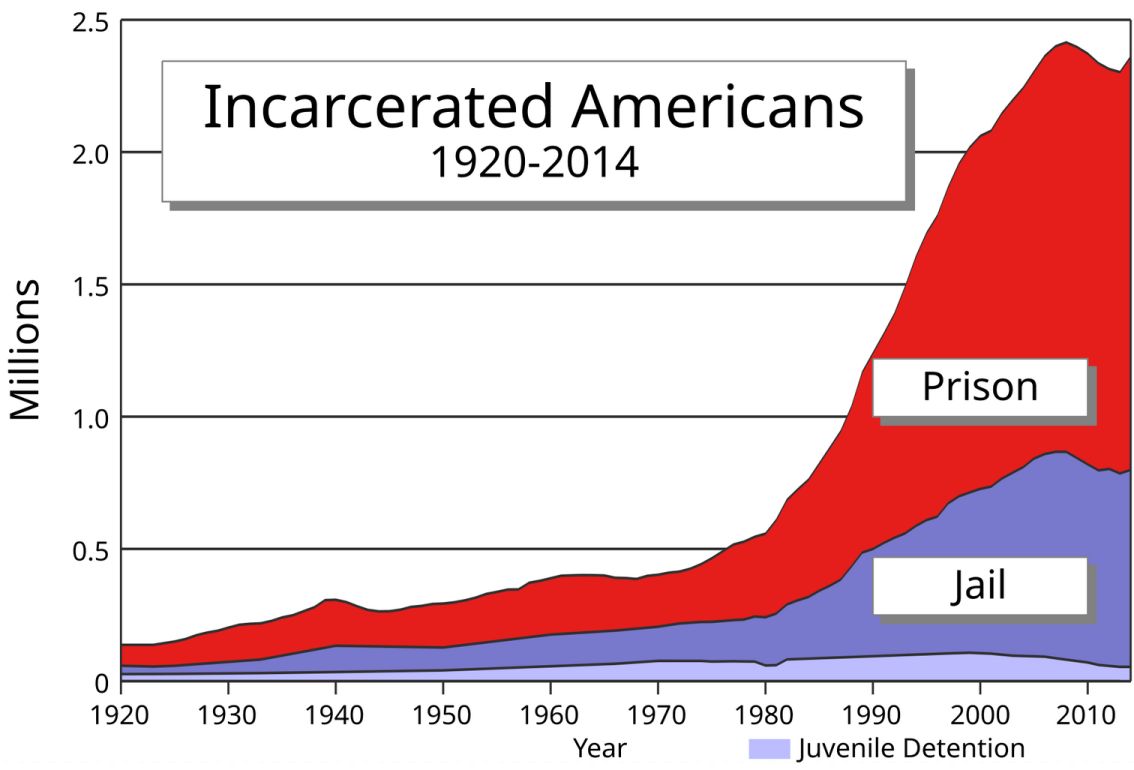 Why does the number of prison inmates correlate to energy consumption and GDP in many rich countries?The number of people in prison increased at about the same level as energy consumption and GDP, but poorer societies can't afford to put so many young and healthy men in prison. Industrial societies are flooded with advertisements that generate all kinds of desires that leave many poor people with ever more frustrations. Furthermore, many people today think of freedom as "following unconditionally one's own desires". Creating huge amounts of desires is good for GDP but bad for everything else, including nature and biodiversity. But artificially creating desires and frustrations to increase consumption is unique in the history of human civilisations.
Why does the number of prison inmates correlate to energy consumption and GDP in many rich countries?The number of people in prison increased at about the same level as energy consumption and GDP, but poorer societies can't afford to put so many young and healthy men in prison. Industrial societies are flooded with advertisements that generate all kinds of desires that leave many poor people with ever more frustrations. Furthermore, many people today think of freedom as "following unconditionally one's own desires". Creating huge amounts of desires is good for GDP but bad for everything else, including nature and biodiversity. But artificially creating desires and frustrations to increase consumption is unique in the history of human civilisations.
Ancient cultures tried to limit desires : do not covet ... (Hebrews), learn contentment (Stoics), be thankful and content with what you have (Christians), all desires are bad for your Karma (Buddhists).
One place in the New York City Rikers prison costs about $200'000 per year, the average cost of a place in a French prison is about €40'000. Shouldn't we think about the usefulness of these "investments" ?
If we understand Justice as an Equality of suffering between victim and perpetrator, we fill prisons without helping the victims. The book shows that we should see "Justice as reparation of the consequences of a crime, restoration of material damage, human suffering and relationships" (see Howard Zehr: Changing Lenses).
The most advanced 2000-watt neighborhoods actively seek cultural, social, economic and generational diversity among their inhabitants, in the pursuite of a common goal: build a piece of the 2000 watt society. The book shows the social and economic benefits of their way of life. Since the poor can't reduce their living standard (energy consumption) very much without starving, socially diverse neighborhoods working together to reach a common goal (2000-watt) can prevent violent social unrest. That's another purpose of the 2000-watt neighborhoods. Either we will succeed to build the 2000-watt society together by cultivating fraternity, or we will fail together with high global warming and all sorts of crises that will tear our ever more fractured democratic societies apart.
 Amish mobilityIn 2020, in the midst of a debate on the adoption of the new 5G phone technology, the President of the French Republic compared environmentalists to the Amish who reject most technical advances. The photos below show that life in the 2000-watt neighborhoods is comfortable and unlike an Amish life-style. Yet, those neighborhoods probably have no more use of the 5G-phones than the Amish do. At the same time, the Amish people we met in the United States seem much happier in their lifestyle than many people in our individualistic consumer societies. In 1965, about 40% of Amish youth left their communities for good, down to less than 5% today, because life in our individualistic societies has probably become much less attractive. (Amish youth has always been encouraged to leave their communities for a period of 3 months to 2 years in order to experience life in society. After that experience, they may freely choose or not to return to their community).
Amish mobilityIn 2020, in the midst of a debate on the adoption of the new 5G phone technology, the President of the French Republic compared environmentalists to the Amish who reject most technical advances. The photos below show that life in the 2000-watt neighborhoods is comfortable and unlike an Amish life-style. Yet, those neighborhoods probably have no more use of the 5G-phones than the Amish do. At the same time, the Amish people we met in the United States seem much happier in their lifestyle than many people in our individualistic consumer societies. In 1965, about 40% of Amish youth left their communities for good, down to less than 5% today, because life in our individualistic societies has probably become much less attractive. (Amish youth has always been encouraged to leave their communities for a period of 3 months to 2 years in order to experience life in society. After that experience, they may freely choose or not to return to their community).
Challenges for democratic societies
 No till "Conservation agriculture" has the potential to store 1 ton of Carbon (3.4 t of CO2) per ha per year in the soil.Societies torn apart by all sorts of conflicts often end up in a political dictatorship or a full-fledged surveillance state. During the last 50 years, the concentration of political and economic power has gradually increased and this process discredits our democracies. At the same time, tensions between major urban centers and the rest of the country are also steadily increasing. As the book shows, such tensions are nothing new. History is full of peasant-wars, and even today, the Chinese metropolis treat migrant rural people really bad, even though these migrant workers build those huge cities. Renewable energy for the cities will be produced in the countryside, and it will not be possible to protect all solar panels and wind-turbines by an armed police.
No till "Conservation agriculture" has the potential to store 1 ton of Carbon (3.4 t of CO2) per ha per year in the soil.Societies torn apart by all sorts of conflicts often end up in a political dictatorship or a full-fledged surveillance state. During the last 50 years, the concentration of political and economic power has gradually increased and this process discredits our democracies. At the same time, tensions between major urban centers and the rest of the country are also steadily increasing. As the book shows, such tensions are nothing new. History is full of peasant-wars, and even today, the Chinese metropolis treat migrant rural people really bad, even though these migrant workers build those huge cities. Renewable energy for the cities will be produced in the countryside, and it will not be possible to protect all solar panels and wind-turbines by an armed police.
Some 2000-watt-neighborhoods also show a way to build bridges over the abyss separating metropolis and the rest of the country. The book shows how they collaborate and build mutual understanding. This collaboration is essential to guarantee sustainable food-production in the post-oil society. Intensive agriculture, which consumes too much energy, is not sustainable. Other forms of agriculture do also store large amounts of CO2 in the soil. Thus, on top of nourishing humanity, agriculture could contribute considerably to the fight against global warming, if only the metropolitan elites treated rural people differently. That is one more area where our choices will have historical consequences. Several 2000-watt neighborhoods, located in large urban centers, show a way forward.
One of the book's hypotheses is that a direct democracy as practiced in Switzerland for the last 700 years strengthens reasonable democratic debate and therefore democracy. Reasonable democratic and contradictory debate is also a bulwark against demagogic power grab. Direct democracy is useful because it helps citizens to learn to think about many sometimes complex issues, to conduct reasonable debates and to feel concerned by the common project of a country. The inhabitants generally take a long-term view on political, economic and environmental issues since they care about the lives of their children and their grandchildren. Politicians tend to take a short-term view that rarely exceeds the length of their political mandate. It should therefore come as no surprise that educated citizens vote for changes that a central and remote government does not dare to force onto its citizens. But would a Swiss-type of direct democracy have a positive educational and pedagogical effect on the people of other nations too, without having to wait for 700 years? The "Vote" menu tries to find an answer to that question.
In the history of mankind, outside of Switzerland, no democracy has reached the age of 300 years. Without the help of the United States, European democracies would have disappeared 80 years ago. Today, at the age of almost 250 years, the American democracy is severely ill since reasonable contradictory debate is on its way out. Even though direct democracy in California looks similar to the Swiss system, it has one substantial difference. The Swiss vote three times each year on about two propositions or referendums. It is possible to have a thorough debate about two proposed laws, but it is not possible to think about all pros and cons and consequences of 20 propositions as is the case in California once every 4 years. As this website shows, Swiss sometimes vote about really complex issues that need thorough debate and thinking. Most human minds are simply not capable to handle 20 complex issues at the same time, but they are able to think about two complex topics every 4 months. Therefore, once every 4 months, such debates are organized by Swiss national television, radio channels, many news-papers and take also place among friends and families. Thus, reasonable debating becomes a way of living and occasional disagreements on one subject may bring people together on another subject. Without a culture of reasonable contradictory debate, democracies may linger and finally disappear. The philosopher Emmanuel Levinas warned us with these words "Freedom consists in knowing that freedom is in danger" (Levinas, Totality and Infinity, an essay on exteriority).
The 2000-watt neighborhoods show that the transition to the post-oil society is the result of a democratic process. Raising the gasoline tax by a few cents produced the yellow vests revolt and 9 months of violence in France. In a democracy, a hierarchical central power will not manage to considerably reduce GDP and individual incomes. The book also develops the thesis that the far-reaching changes needed to build the 2000-watt society come more easily through referendums than through a usually contested remote central power. Thus, during the last 12 years, the inhabitants of several large cities have voted to move towards the 2000 watt society, and in 2017, the Swiss voted for a law demanding an energy reduction of 43% until 2035. But to convince citizens about drastic changes, democratic societies need models of a desirable and sustainable way of life. The 2000-watt neighborhoods were designed for this purpose and seem to confirm the researcher's ideas that invented the concept at the Swiss Federal Institute of Technology. To date, there exist thirty-nine 2000-watt-neighborhoods, housing between 300 and 3000 inhabitants and offering about the same number of jobs. Seeing the life in these neighborhoods, citizens of large cities or counties voted for the changes needed to create a 2000-watt society. These changes are not contested thereafter since they were approved by referendum, often by comfortable majorities.
As described in the book, the site offers to vote on three ballots that have taken place in Switzerland over the past 20 years. The three ballots have different levels of complexity. The texts and arguments of the propositions are accessible in the “Vote” menu. The book's hypothesis is that, confronted with the same arguments, the French, Germans or English would vote much like the Swiss.
If the number of voters on this website is large enough, the government and the media will be informed about the results.
For each vote, a forum allows visitors to add and discuss further arguments in favor or against the proposed law, just as the Swiss usually do.
Photos of 2000-watt neighborhoods
 Annual 2000-watt neighborhood party in Zurich Oerlikon
Annual 2000-watt neighborhood party in Zurich Oerlikon
 Playground shared between a school and the 2000-watt neighborhood in Zurich Oerlikon
Playground shared between a school and the 2000-watt neighborhood in Zurich Oerlikon
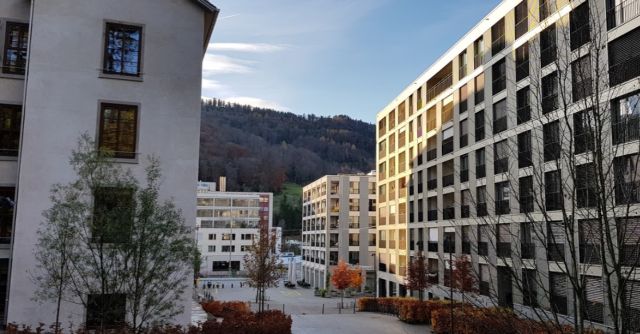 The 2000-watt neighborhood GreenCity in Zurich, between a highway and a railway, close to forests with many hiking trails. The old building on the left is a former textile factory, converted into apartments and lofts and renovated to the very low energy consumption standard called "Minergie-plus".
The 2000-watt neighborhood GreenCity in Zurich, between a highway and a railway, close to forests with many hiking trails. The old building on the left is a former textile factory, converted into apartments and lofts and renovated to the very low energy consumption standard called "Minergie-plus".
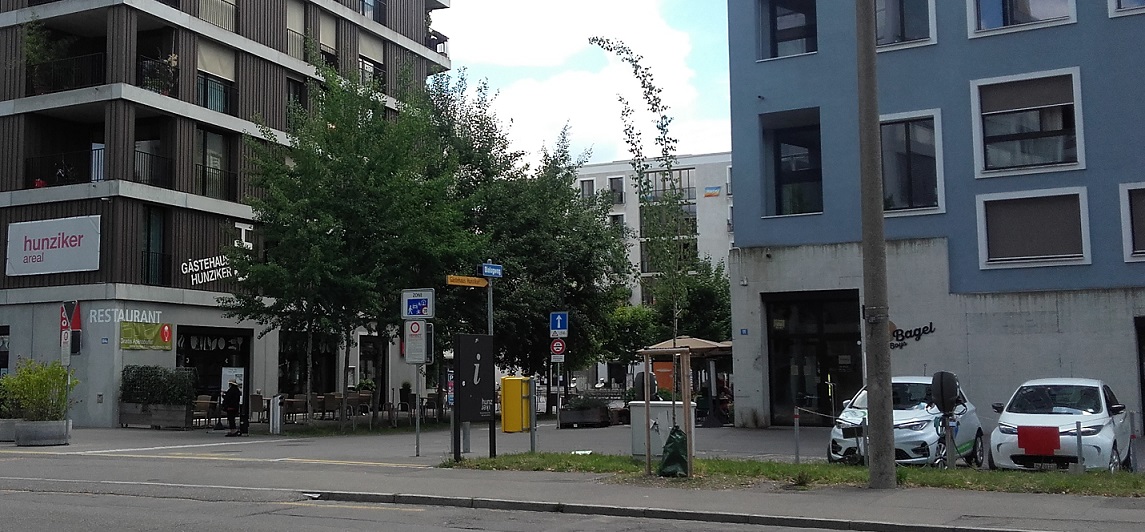 Parking with a charging station for electric cars belonging to the 2000 watt neighborhood in Zurich Oerlikon. These cars can be rented easily using the neighborhood specific mobile phone app. The same application is also used to monitor energy consumption of the apartment in real time, to make a reservation in one of the neighborhood restaurants, to reserve and rent a common room, etc.
Parking with a charging station for electric cars belonging to the 2000 watt neighborhood in Zurich Oerlikon. These cars can be rented easily using the neighborhood specific mobile phone app. The same application is also used to monitor energy consumption of the apartment in real time, to make a reservation in one of the neighborhood restaurants, to reserve and rent a common room, etc.
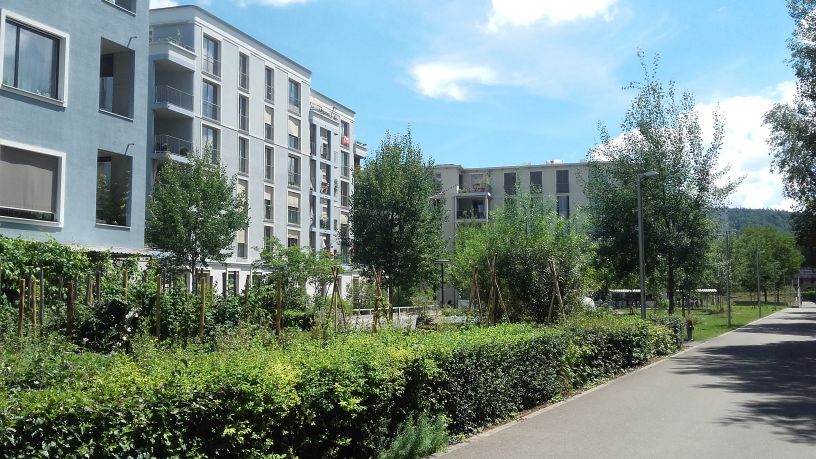 On the left: 2000-watt neighborhood in Zurich Oerlikon with a few square meters for biodiversity.
On the left: 2000-watt neighborhood in Zurich Oerlikon with a few square meters for biodiversity.
 Inner court of the 2000-watt-neighborhood called Kalkbreite. Eight tramways are stationed below this court.
Inner court of the 2000-watt-neighborhood called Kalkbreite. Eight tramways are stationed below this court.
The following co-ownership building is not part of a 2000-watt neighborhood, but its residents took the 2000-watt referendum vote seriously. They wrote their contract with the rest of the world on the facade of the building. The building is located at Badenerstrasse 380, 8004 Zürich. Here is the translation of the contract (German "Vertrag"):
This contract binds the inhabitants of this building to do whatever is needed to reduce their constant energy consumption to a maximum of 2000 watts. If this commitment is not respected, the rest of the world has the right to damages. Place of Jurisdiction: Zürich. Applicable law: Swiss law. Signed: the inhabitants of this building.
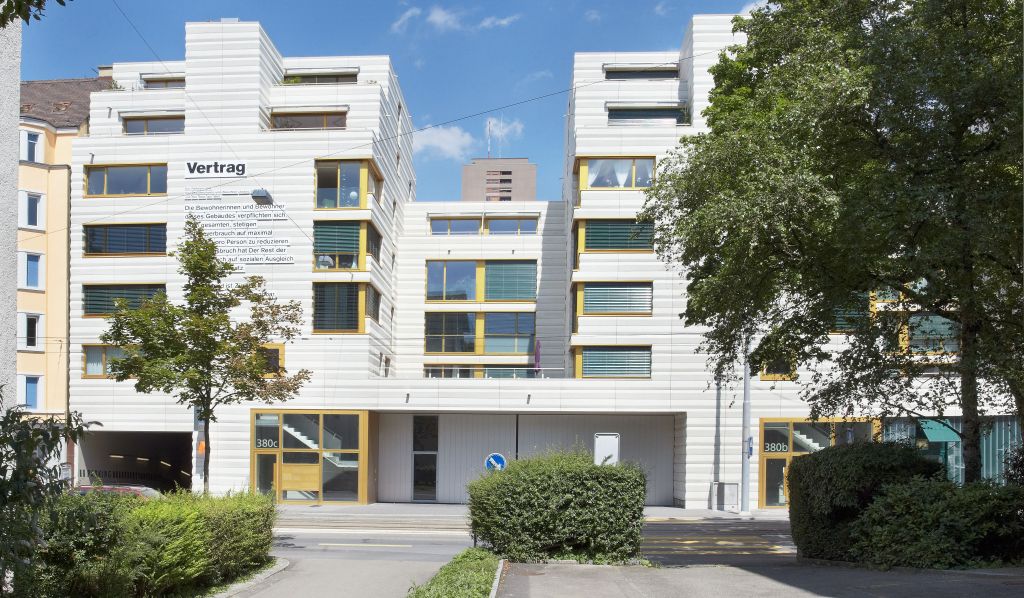
Footnotes
[1] ˄ IEA, World energy investment 2019, page 19: In 2018 in Europe, 140 billion were invested in the entire energy sector: production of fossil fuels, production of electricity with coal, gas, renewables and nuclear. In addition, 70 billion have been invested in improving energy efficiency, for example by improving building insulation. Europe would have to invest 400 billion per year for the next 30 years to replace a third of fossil fuels with renewables and thus create the energy sources for 2000-watt society. Current investments should therefore be multiplied by three. Since energy use in North America is about 40% higher than in Europe, investments for non-carbon energy sources would have to be higher too. Between a quarter and a third of fossil fuels can be saved by energy efficiency gains (e.g. better insulation of buildings) and more than a third must be saved by a reduction in individual wealth (reduction in GDP) if global warming is to be limited to 2°C.
[2] ˄ IEA, World energy investment 2019, RD&D and new technologies, 2019
[3] ˄ After completing the calculations, the astronomical numbers prompted the author to abandon 40 years of anti-nuclear activism. The goal of the book is therefore not to defend an ideal theory with literary eloquence, but to propose practical and feasible solutions. The book discusses different nuclear options. Because of the initial investment and the high long-term cost of nuclear power-stations, replacing all fossil fuels with nuclear power is not the solution to the problem of mankind's limited means on a limited planet.
[4] ˄ Total Consumer Power Consumption Forecast, Anders Andrae, page 20. It is assumed that Moore's law will come to an end by around 2025, as investments for new electronic circuit manufacturing plants has grown exponentially over the past 8 years. Investments for a new production line of 5nm structures already reach around 50 billion dollars in 2022 and probably only one or two companies in the world will be capable tp produce circuits using 5nm and 3nm structures. Thus, after 2025, the energy efficiency of data centers will probably increase much slower than the volume of data due to 5D phone technology, artificial intelligence and metaverses.
[5] ˄ All molecules composed of at least three atoms [H2O, CO2, CH4, N2O, ...) absorb the earth's long-wave radiation and therefore become warmer. They then radiate part of that absorbed heat back to the earth. This physical effect is called the greenhouse effect and produces global warming. Like all other oxides, CO2 molecules are extremely stable, which makes the process of global warming almost irreversible. Without any of these greenhouse gases, the earth would be 20°C colder and would have the average temperature of the moon.
[6] ˄ Examples: In 2020, according to real estate brokerage firm Redfin, in California alone, real estate worth $ 2000 billions is now in areas at risk of wildfires. Since the 2019 floods, in the Texas city of Houston alone, 220 000 homes are now in areas at risk of flooding. Consequences: In these areas, insurance premiums rise rapidly and house prices fall. These indirect losses are not included in the disaster cost calculations. Calculated for the whole world, the indirect and direct losses are already huge, and they will increase exponentially with each degree of global warming. In 2020 in the United States, direct losses due to fires and floods were $ 95 billion (TIME, 05/17/2021 p.67). The Global Commission on Adaptation (GCA) writes in its latest report that we must also invest to adapt to climate change, for example investing to make infrastructure more resilient, develop agriculture for dryer seasons and protect mangroves. $ 1 invested today will avoid losses of $ 7 in 2030.
The direct and indirect costs of climate change were calculated and estimated already in 2006 by Nicholas Stern, in his voluminous report "Review on the Economics on Climate Change", London School of Economics. The report is very well documented, ... and has been largely ignored. In a paper published in 2019, Nicholas Stern and Andrew Oswald from Warwick university made this observation: "Of the 77 000 articles published by the most renowned academic journals in economics, only 57 concerned the topic of climate change, i.e. a proportion of 0.074%".
[7] ˄ IEA, Sustainable Recovery Tracker, July 2021. Furthermore, demand for high-energy-coal used for electricity production is expected to rise considerably.
[8] ˄ Institute Othering & Belonging, university of Berkley California, Most to Least Segregated Cities. In 2019, 80% of cities with more than 200,000 inhabitants had more racial, ethnic, social and political segregation than in 1990. This segregation increases the polarization of society. Stephen Menendian, director of the institute, concludes: "This country is still in dire shape".
[9] ˄ Stanford Institute for Economic Policy Research, Cross-country trends in affective polarization, jan.2020. In 1978, on a scale of 0 to 100, Americans rated the difference in their feelings towards members of their own preferred political party compared to those towards of the other party at 27. On the same scale, if Americans learn which party a person is voting for, the difference of feeling increased to 56 in 2019. According to this paper, American political parties have become "conglomerates of identity tribes". Yet, in countries like Germany, Norway and Switzerland, affective polarization has declined since 2000.
[10] ˄ Psychology Today, Why Is Narcissism Increasing Among Young Americans?, Peter Gray, Jan 2014




